 MicroProse Software - Part 2
MicroProse Software - Part 2
The Independent Years (1982-1992)
In Part 2, I explore the years in which MicroProse was its own company, and began to grow at an exponential rate, but not without its challenges.
1985
 Silent Service, a submarine simulator, was ported to MS-DOS in 1985. It was first released on the Apple II, Commodore 64, Sinclair ZX Spectrum and Amstrad CPC464. The design of the game came from Sid Meier with graphics by Michael Haire.
Silent Service, a submarine simulator, was ported to MS-DOS in 1985. It was first released on the Apple II, Commodore 64, Sinclair ZX Spectrum and Amstrad CPC464. The design of the game came from Sid Meier with graphics by Michael Haire.
Silent Service was in development for 8 months and its creation was inspired by a fractal technological trick. Set in the Pacific Ocean during World War II, with the player assuming control of a U.S. Gato-class submarine for various war patrols against Japanese shipping. "Silent Service" was a nickname for the US Navy's submarine force in the Pacific during World War II. The player can choose when to attack from a range of realistic tactics, including the End Around and near invisibility at night (if the sub's profile is kept to a minimum). It allows four projectiles concurrently, a challenge when battling multiple destroyers. Real-time is accelerated when not in combat.





Silent Service in 16-colour EGA (320 x 200)
Sid Meier described several key factors that influenced the design of the game: The size of the theater, the variety of tactical situations, and evolving technology, such as the use of surface radar and torpedoes that did or did not leave trails of bubbles on the surface—only simulations set after their real-life introduction had access to these. Tasks such as navigation, damage repair, and firing were compartmentalized into different screens to allow players access to a great deal of information, but also to focus on the immediate task.
 Also in 1985, MicroProse developed F-15 Strike Eagle. This was also a game that was started on the 8-bit computers, and was ported the same year to DOS as a PC Booter by MicroProse's Randall Don Masteller who had worked on Solo Flight and Silent Service. According to Sid Meier, it was the first game where they had worked out how to do 3D math, which they used to simulate rotating objects. The only other title that was using 3D calculations in a flight sim at that time was Microsoft Flight Simulator, but Meier's goal with F-15 Strike Eagle was to retain the fun factor for the gamer. For this the game needed to have an achievable goal rather than being open-ended.
Also in 1985, MicroProse developed F-15 Strike Eagle. This was also a game that was started on the 8-bit computers, and was ported the same year to DOS as a PC Booter by MicroProse's Randall Don Masteller who had worked on Solo Flight and Silent Service. According to Sid Meier, it was the first game where they had worked out how to do 3D math, which they used to simulate rotating objects. The only other title that was using 3D calculations in a flight sim at that time was Microsoft Flight Simulator, but Meier's goal with F-15 Strike Eagle was to retain the fun factor for the gamer. For this the game needed to have an achievable goal rather than being open-ended.
The seven missions featured in this simulation of F-15 flight were all real-life missions the plane was originally used in. They took place in the Middle East and Asia during the 1970s and early 1980s, and had air and ground targets to destroy. You had machine guns, guided missiles and bombs at your disposal. The game featured an arcade mode and 3 further difficulty levels. It also had 3 enemy aircraft and 3 types of enemy SAMs.
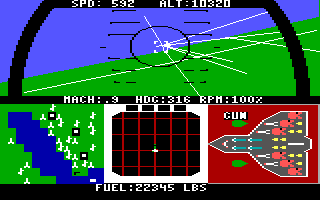

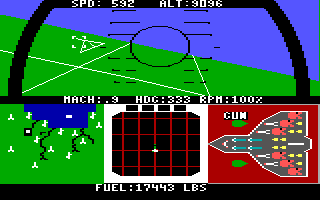
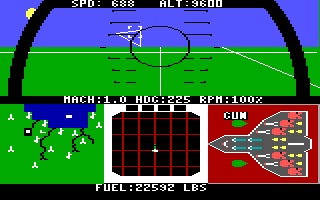
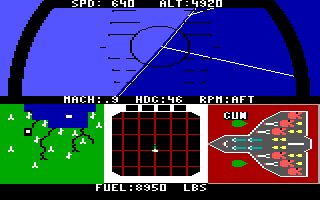
It came with graphics support for Tandy/PCjr, CGA and EGA, which ran in 160 x 200 with 16 colours. It also supported a special Amstrad PC1512 mode which was essentially an enhanced CGA. So the game could run on an original IBM PC or PC/XT with minimal specs, the game was designed to require only 128 KB of RAM.
1986
By 1986 MicroProse had reached $10 million in sales.
 Conflict in Vietnam was developed this year and released in September. It was the third and final installment in Microprose's "Command" series of war games (the first two being Crusade in Europe and Decision in the Desert, both released in 1985). It simulates five key battles in Vietnam, beginning with the defeat of the French colonial army in 1954 and culminating in the 1972 victory of the Viet Cong against South Vietnam forces.
Conflict in Vietnam was developed this year and released in September. It was the third and final installment in Microprose's "Command" series of war games (the first two being Crusade in Europe and Decision in the Desert, both released in 1985). It simulates five key battles in Vietnam, beginning with the defeat of the French colonial army in 1954 and culminating in the 1972 victory of the Viet Cong against South Vietnam forces.
The simulation calculates a day-night-cycle, weather, terrain, supply lines, formations, unit organization and experience, to name only the most important factors. Two players can compete head to head on one computer, soloists may randomize the enemy priorities in some scenarios for added uncertainty on the battlefield.
1987
 By 1987, Computer Gaming World considered MicroProse one of the top five computer game companies, alongside likes of Activision and Electronic Arts. The PC market was the company’s top priority, along with the Commodore 64.
By 1987, Computer Gaming World considered MicroProse one of the top five computer game companies, alongside likes of Activision and Electronic Arts. The PC market was the company’s top priority, along with the Commodore 64.
An early port from MicroProse to the DOS operating system was Sid Meier's Pirates! which arrived this year following its huge success on the 8-bit home computer platforms. The idea for Pirates! started in early 1986 when Meier and fellow MicroProse designer Arnold Hendrick wanted to create a role-playing adventure game, but Meier's business partner Bill Stealey was skeptical of producing non-vehicle simulations. The company planned several game elements that it removed before release, including multiple NPCs (Non-Player Characters) per town, more detailed sailing including fleet actions, and a subplot involving religion and nobility. Pirates!' success resulted in the similar Sword of the Samurai two years later.
 The game was initially written for the Commodore 64, and was the first game to make use of compression for the images. The DOS conversion came almost a year after the original Commodore 64 release, along with an Apple ][ GS release at the same time.
The game was initially written for the Commodore 64, and was the first game to make use of compression for the images. The DOS conversion came almost a year after the original Commodore 64 release, along with an Apple ][ GS release at the same time.
With five successful years behind him, Microprose considered star designer Sid Meier a selling point and chose to put his name on the box of this game - a first for the company.
The single-player open-world game is a simulation of the life of a pirate, a privateer, or a pirate hunter in the 16th, 17th and 18th centuries. The player receives a letter of marque authorizing service as a privateer for the Spanish Empire, the Dutch Republic, the Kingdom of England, or the French colonial empire in the Caribbean. The player's loyalties may change over the course of the game; they may also hold rank with multiple countries and may turn to piracy at any time. Gameplay is open-ended; the player may choose to attack enemy ships or towns, hunt pirates, seek buried treasure, rescue long-lost family members, or even avoid violence altogether and seek to increase their wealth through trade.
It was followed with a remastered version, Pirates! Gold, in 1993.
 In September, Gunship was released on DOS, after its debut on the 8-bit computers in October the year before.
In September, Gunship was released on DOS, after its debut on the 8-bit computers in October the year before.
This combat flight simulation put you at the helm of the AH-64 Apache, the new "gunship" of the US Army. The game recreates the weapons, flight systems, and performance of the real machine, with the player controlling an arsenal that includes laser-guided Hellfire missiles, a 30mm cannon controlled by helmet gunsights, clusters of bombardment rockets--even air-to-air missiles for duels with enemy helicopters.
 There were hundreds of missions in any one of four regions of the world, including Southeast Asia, Central America, the Middle East, and the Soviet Union and its Warsaw Pact allies in Western Europe.
There were hundreds of missions in any one of four regions of the world, including Southeast Asia, Central America, the Middle East, and the Soviet Union and its Warsaw Pact allies in Western Europe.
MicroProse kept up their reputation with an excellent and heavy manual describing in detail not just the game's controls but also the history and strategies to use.
1988
In 1988, the company acquired the arm of British Telecom, Telecomsoft, who had been developing computer games for the 8-bit home computer market using the labels Firebird, Silverbird and Rainbird. MicroProse continued to use the Firebird and Rainbird labels for a few more years, with such releases as Midwinter, Rick Dangerous, and Savage.



MicroProse acquisitions in 1988
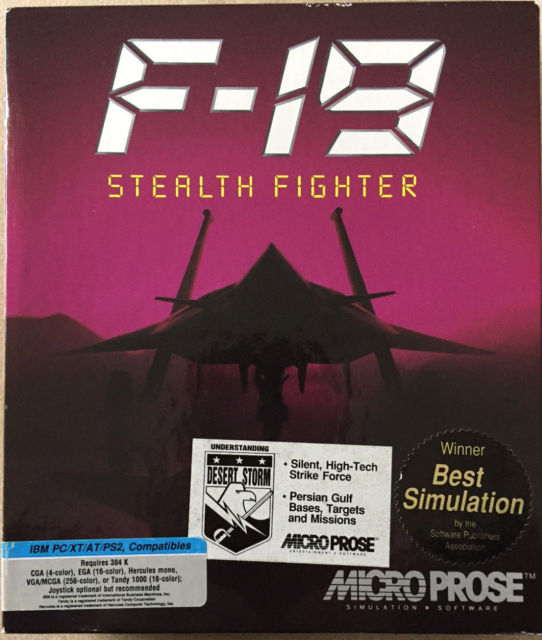
The player takes on the role of a pilot flying missions of varying difficulty over four geographic theatres of war: Libya, the Persian Gulf, the North Cape, and Central Europe. The game can be played under conditions of conventional warfare, limited warfare, or cold war (in the latter, even being detected by the enemy can lead to a major diplomatic incident).
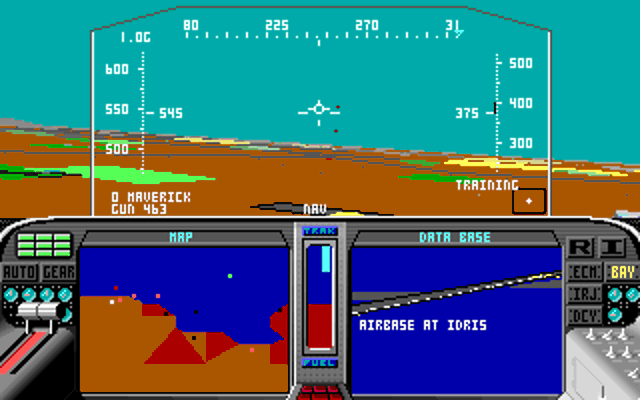 The player can choose appropriate ordnance from a wide range of realistic armaments, and the game features convincing behaviour from AI-controlled units such as enemy aircraft, SAM sites and radar stations. These behave in accordance with the situation – patrolling at first, but launching into a highly aggressive search if the player is detected. Other features of the game are a realistic system of radar detection, where the player's varying radar signature is visually compared with the energy of incoming radar pulses at different ranges and powers, and a variety of endings appropriate to the outcome of each mission. These include the player being rescued by a V-22 Osprey, a Pravda newspaper headline proclaiming the capture of the pilot, or an outraged ally or neutral nation protesting the destruction of their aircraft.
The player can choose appropriate ordnance from a wide range of realistic armaments, and the game features convincing behaviour from AI-controlled units such as enemy aircraft, SAM sites and radar stations. These behave in accordance with the situation – patrolling at first, but launching into a highly aggressive search if the player is detected. Other features of the game are a realistic system of radar detection, where the player's varying radar signature is visually compared with the energy of incoming radar pulses at different ranges and powers, and a variety of endings appropriate to the outcome of each mission. These include the player being rescued by a V-22 Osprey, a Pravda newspaper headline proclaiming the capture of the pilot, or an outraged ally or neutral nation protesting the destruction of their aircraft.
For the PC, it received rave reviews at launch, and Computer Gaming World recognized F-19 as the "Simulation Game of the Year" in 1987.
More ports arrived on MS-DOS in 1988, including Carrier Command and MicroProse Soccer. Two strategy games were new for 1988 with Red Storm Rising and The President is Missing. On the arcade side, we also got Starglider 2 and Savage.
Another port from the 8-bits also came out on DOS this year- Airborne Ranger.
1989
 In 1989 MicroProse released F-15 Strike Eagle II, an excellent follow-up to F-19 Stealth Fighter from the year before, with VGA graphics and better audio support. The design goal for F15SE2 was to be more 'fun' and less 'sim', having recognised that F-19 was, for its time, a complex flight simulation, and perhaps perceived as difficult. F-15 had a more clear keyboard layout while retaining its core flight sim roots.
In 1989 MicroProse released F-15 Strike Eagle II, an excellent follow-up to F-19 Stealth Fighter from the year before, with VGA graphics and better audio support. The design goal for F15SE2 was to be more 'fun' and less 'sim', having recognised that F-19 was, for its time, a complex flight simulation, and perhaps perceived as difficult. F-15 had a more clear keyboard layout while retaining its core flight sim roots.
F-15 Strike Eagle II comes with four scenarios: Libya, Persian Gulf, Vietnam and Middle East. In a mission the player has to fight a variety of enemy aircraft, missile boats, satellite stations and other ground targets, to take out one primary and one secondary target, making sure to not attack friendly targets. Promotions and medals are based on the mission score.
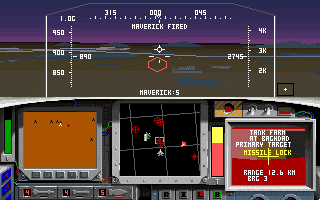 It was also noted that you could import the theatres of war from F-19 into F15SE2 and play those too, since they retained the same file format!
It was also noted that you could import the theatres of war from F-19 into F15SE2 and play those too, since they retained the same file format!
Also in 1989, three other MicroProse-developed titles were released: M1 Tank Platoon, Midwinter and Sword of the Samurai. They also published two externally-developed games - Rick Dangerous and Stunt Car Racer.
1990
In 1990, MicroProse dropped the ex-Telecomsoft labels Firebird and Rainbird. All subsequent titles would be under the MicroProse banner. This was also the year MicroProse attempted to diversify beyond its niche roots as a sim and strategy game company. Encouraged by the success of Pirates!, MicroProse designed further action-strategy titles in 1990, including Covert Action and a year later, Hyperspeed.
 Sid Meier's Railroad Tycoon was possibly the biggest AAA title to be released in 1990. Meier had been working on it in the background for a while, and met with some resistance from Stealey when he proposed they release the game because it wasn't a military simulator.
Sid Meier's Railroad Tycoon was possibly the biggest AAA title to be released in 1990. Meier had been working on it in the background for a while, and met with some resistance from Stealey when he proposed they release the game because it wasn't a military simulator.
The objective of the game is to build and manage a railroad company by laying tracks, building stations, and buying and scheduling trains. The player acts as a railway entrepreneur and may start companies in any of four geographic locales: the Western United States, Northeast United States, Great Britain, or Continental Europe; the starting date varies depending on the map chosen. The company starts with one million dollars in capital, half as equity, half as a loan. The company may raise additional capital through the sale of bonds.
 The player manages the business as described above and may also handle individual train movement and build additional industries. The game models the supply and demand of goods and passengers, as well as a miniature stock market on which players can buy and sell stock of their own or competing companies. The game also has other railroad companies attempting to put the player out of business with stock dealings and rate wars.
The player manages the business as described above and may also handle individual train movement and build additional industries. The game models the supply and demand of goods and passengers, as well as a miniature stock market on which players can buy and sell stock of their own or competing companies. The game also has other railroad companies attempting to put the player out of business with stock dealings and rate wars.
There are four types of stations: Signal Tower, Depot, Station and Terminal. The Signal Tower acts as a passing loop and may control movements. The rest service surrounding areas, with Depots serving the smallest area and Terminals the largest. The player can build at most 32 stations. When the player builds the first station they also build their first engine shop. Trains can only be built at engine shops. The player can upgrade and downgrade Depots, Stations and Terminals as necessary, and can add other facilities such as stores and hotels.
Once the player builds a station they can build their first train (of the 32 permitted) at any engine shop. The player can then add cars to the train and send it on its way. The player can at any time change the consist, with options including mail and passenger cars as well as specialized freight cars for each of the game's nine other commodity types.
The player can continue to build the track network and build stations until they run out of funds. The game runs for a century, with accounting periods being two years long.
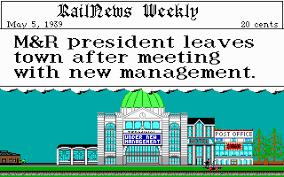
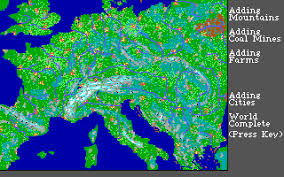

Not every station buys everything offered to it. Some goods producers buy nothing. There are two economic models the player can choose between: Simple Economy (where a station serving a large enough city will buy anything) and Complex Economy (where cities will only buy certain products such as passengers and beer). The four geographical scenarios have different products available.
Two more simulations were launched this year with Knights of the Sky, a World War I combat simulation, and Silent Service II, the sequel to the 1985 hit title, Silent Service.
Other releases this year included Command HQ, Covert Action, International Soccer Challenge, Space 1889, Rick Dangerous 2, Lightspeed and The Punisher.
1991
In August 1991, MicroProse filed for an Initial Public Offering. The company raised over $25 million to help repay debts from its unsuccessful arcade games (F-15 Strike Eagle: The Arcade Game and Battle of the Solar System). During the same period, MicroProse created two labels: MicroStyle (UK), and MicroPlay Software (US), using them to publish a variety of externally developed games, such as Challenge of the Five Realms, Global Conquest, Elite Plus, Flames of Freedom, Rick Dangerous, Stunt Car Racer, Xenophobe and XF5700 Mantis


Two new labels formed in 1991: MicroStyle and MicroPlay
MicroProse began to experiment with the role-playing genre in 1991 by publishing The Legacy: Realm of Terror. They would follow up in subsequent years by developing their own in-house titles Darklands (1992) and BloodNet (1993).
 In 1991, Sid Meier's Civilization was released, inspired by the Avalon Hill board game of the same name. It was designed by Sid Meier and Bruce Shelley, and developed by its internal division, MPS Labs, on multiple platforms (though DOS was the first). Critically acclaimed, it quickly became one of the best-selling strategy games of all time and spawned multiple sequels.
In 1991, Sid Meier's Civilization was released, inspired by the Avalon Hill board game of the same name. It was designed by Sid Meier and Bruce Shelley, and developed by its internal division, MPS Labs, on multiple platforms (though DOS was the first). Critically acclaimed, it quickly became one of the best-selling strategy games of all time and spawned multiple sequels.
Civilization is a turn-based single-player strategy game. The player takes on the role of the ruler of a civilization, starting with one (or occasionally two) settler units, and attempts to build an empire in competition with two to seven other civilizations. The game requires a fair amount of micromanagement (although less than other simulation games). Along with the larger tasks of exploration, warfare and diplomacy, the player has to make decisions about where to build new cities, which 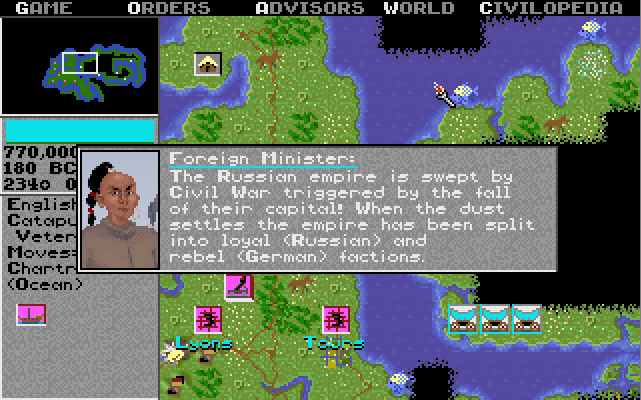 improvements or units to build in each city, which advances in knowledge should be sought (and at what rate), and how to transform the land surrounding the cities for maximum benefit. From time to time the player's towns may be harassed by barbarians, units with no specific nationality and no named leader. These threats only come from huts, unclaimed land or sea, so that over time and turns of exploration, there are fewer and fewer places from which barbarians will emanate.
improvements or units to build in each city, which advances in knowledge should be sought (and at what rate), and how to transform the land surrounding the cities for maximum benefit. From time to time the player's towns may be harassed by barbarians, units with no specific nationality and no named leader. These threats only come from huts, unclaimed land or sea, so that over time and turns of exploration, there are fewer and fewer places from which barbarians will emanate.
The player is tasked with leading an entire human civilization over the course of several millennia by controlling various areas such as urban development, exploration, government, trade, research, and military. The player can control individual units and advance the exploration, conquest and settlement of the game's world. The player can also make such decisions as setting forms of government, tax rates and research priorities. The player's civilization is in competition with other computer-controlled civilizations, with which the player can enter diplomatic relationships that can either end in alliances or lead to war.
In 1991, a scenario disk for F-15 Strike Eagle II was released called F-15 II Operation Desert Storm. It added three new scenarios, two from the earlier F-19 Stealth Fighter, North Cape and Central Europe, and a new scenario based on the contemporary Gulf War called Desert Storm. In addition, night missions, improved sound support and new weapons were included.
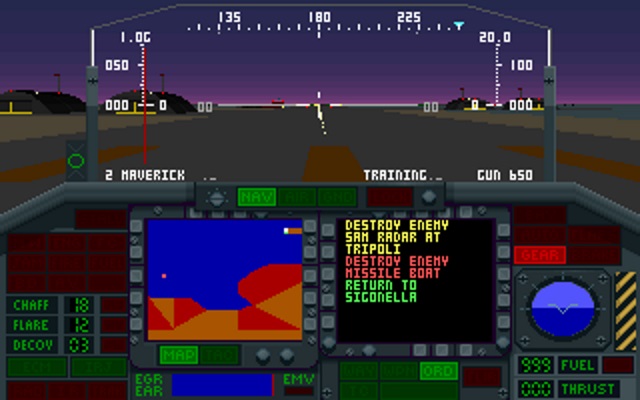 Also this same year, F-117A Nighthawk: Stealth Fighter 2.0 arrived, which was the spiritual successor of F-19 Stealth Fighter from 1988.
Also this same year, F-117A Nighthawk: Stealth Fighter 2.0 arrived, which was the spiritual successor of F-19 Stealth Fighter from 1988.
With much-improved graphics it was a kind of blend of the newer technological capabilities of F-15 Strike Eagle II with the stealth nature of gameplay from F-19 Stealth Fighter. Since the US Air Force had now publicly announced their new stealth aircraft, this game was able to base its aircraft model correctly on the real thing.
Also in 1991, they released Spectrum Holobyte's long-awaited Falcon 3.0.
From MPS Labs came Formula One Grand Prix by Geoff Crammond. In the US it was sold under the title "World Circuit". This was ground-breaking at the time, both for its ability to configure aspects of the car and 3D graphics. Indianapolis 500 had been out for almost two years already, and was the first to bring out a car racing sim with 3D polygons, but F1GP was the first to provide access to a full season of accurately-mapped racing circuits and pioneered the concept of driver aids to help beginners get used to the car (something that was adopted by almost every racing sim developer going forward).
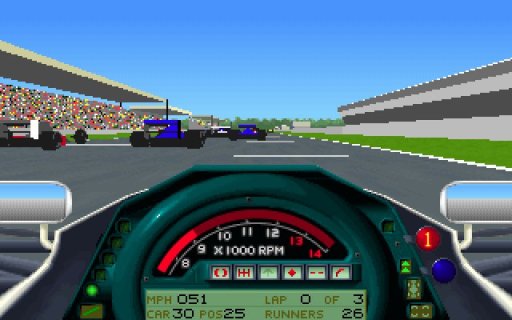

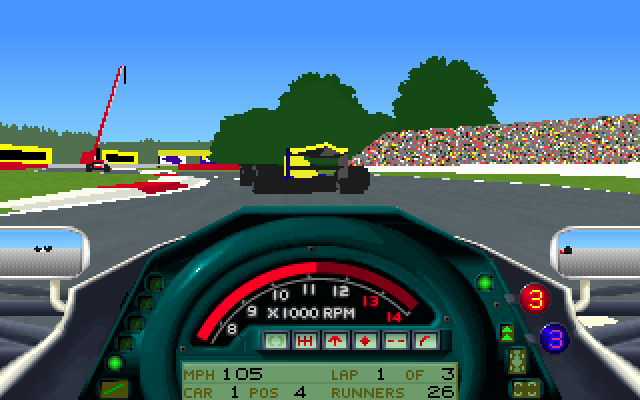
Formula One Grand Prix, aka World Circuit (1991)
F1GP also provided multiplayer support, either on a single computer where you would switch into the drivers seat periodically to take your turn and the computer would drive the car temporarily, or on several computers connected over a local network.
MPS Labs also released Crisis in the Kremlin, and Gunship 2000 in 1991.
On the publishing side, MicroProse had a very busy 1991 with MicroProse Golf (aka David Leadbetter's Greens or David Leadbetter's Golf), Hyperspeed, Super Tetris, Troika, Twilight: 2000, The Legacy: Realm of Terror,
Elite Plus and Midwinter 2: Flames of Freedom.
1992
In 1992, with a new Board of Directors and a newly hired MicroProse Chief Operating Officer for the USA Division, Stealey left the company for 6 months for a sabbatical to travel, make speeches on Entrepreneurism at business schools, and work on his golf game. MicroProse had been working on creating their own adventure game engine, and the first title based on this was launched in 1992 - Rex Nebular and the Cosmic Gender Bender. The engine was subsequently used on just two titles, Return of the Phantom (1993) and Dragonsphere (1994), before being dropped. The engine was then sold to Sanctuary Woods.
Also in 1992 MicroProse acquired Paragon Software. They also acquired UK Leeds-based flight simulation developer Vektor Grafix, who had already developed titles for them such as B-17 Flying Fortress. MicroProse turned their offices into a satellite development studio named MicroProse Leeds.
 Six great new AAA games were due on Oct 1, 1992. When Stealey returned in September 1992, it was discovered none of the games were ready. In the end, MPS Labs only put out one AAA title,
Six great new AAA games were due on Oct 1, 1992. When Stealey returned in September 1992, it was discovered none of the games were ready. In the end, MPS Labs only put out one AAA title,
F-15 Strike Eagle III, on December 15th, 1992. Cash was becoming an issue for the company.
The game offered a further enhancement in visual fidelity with beautiful graphics and a fresh set of theatres in Panama, North Korea and Iraq (Operation: Desert Storm). Anyone who enjoyed F-15 SE2 will love this one. It retained the more arcade-style of gameplay of the earlier game but added more complexity, including laser targeting. And a new features to the series... you could even play co-op with a friend with both of you in the same plane!
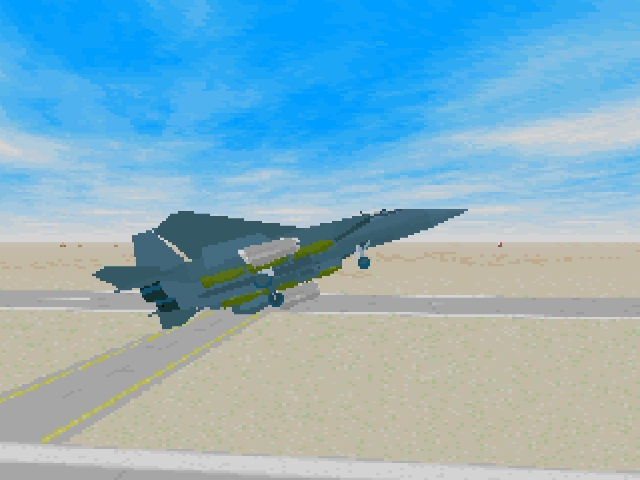

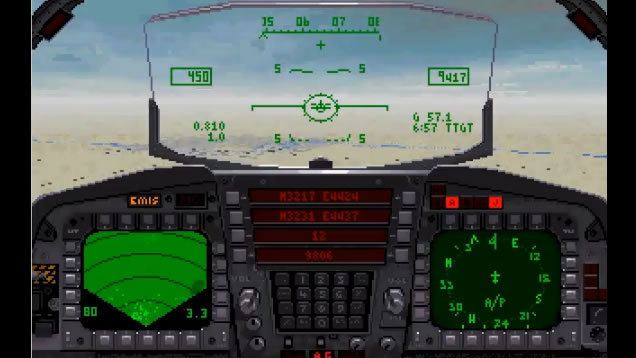
F-15 Strike Eagle III in 256-colour VGA
Also this year, three more flight sims were released, Harrier Jump Jet, B-17 Flying Fortress (developed by Leeds-based Vektor Grafix), and The Ancient Art of War in the Skies.
Other titles from this year include ATAC: The Secret War Against Drugs, Darklands, Task Force 1942 and Special Forces.
The first expansion for Falcon 3.0 arrived in the form of Operation Fighting Tiger and for Gunship 2000 also came 1992: Islands & Ice.
The publishing side of MicroProse put out Sea Rogue, Challenge of the Five Realms, Global Conquest and XF5700 Mantis.
In our final Part 3, we explore the acqusition of MicroProse by Spectrum Holobyte.